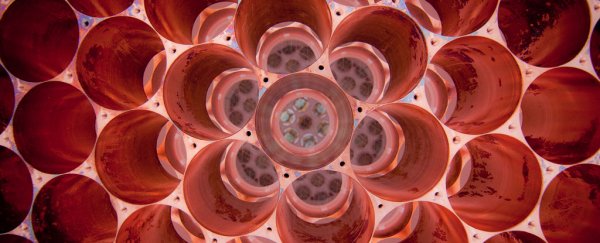For something that's hypothesised to make up more than 80 percent of the mass of the entire Universe, it's no easy thing to detect the existence of dark matter.
That's the conclusion the world is coming to today, after scientists announced that a massive $10 million experiment to find traces of elusive dark matter particles had failed after an exhaustive 20-month search.
"We've probed previously unexplored regions of parameter space with the aim of making the first definitive discovery of dark matter," said physicist Cham Ghag from University College London in the UK, one of the scientists who took part in the Large Underground Xenon (LUX) project based in South Dakota.
"Though a positive signal would have been welcome, nature was not so kind! Nonetheless, a null result is significant as it changes the landscape of the field by constraining models for what dark matter could be beyond anything that existed previously."
While we can't see, feel or detect dark matter in the observable Universe, scientists nonetheless estimate that it makes up the majority of the Universe's mass.
Why? Because of gravitational effects that we can perceive that can't be explained otherwise – such as the way that light bends as it travels through the cosmos, and because of how galaxies rotate.
But unlike the observable matter that makes up everything we physically register, dark matter particles are thought to pass through us, almost like ghosts, barely interacting with us, at least not on any levels that we can scientifically detect.
"Over 80 percent of our matter is in this dark matter form," LUX scientist Richard Gaitskell from Brown University told media at a press event announcing the end of this phase of the dark matter search.
"You and I are the flotsam and jetsam; dark matter is the sea," he added. "That's why one doesn't give up. We've got to figure out what this dark matter component is."
Which is why it's so disappointing that the LUX experiment has failed to find what it was looking for after such a massive, concentrated effort.
Located in a former gold mine a mile underneath the city of Lead in South Dakota, the researchers were aiming to detect weakly interacting massive particles (WIMPs), which are currently considered the most viable candidate for dark matter.
It was thought that the facility's sheltered location under so much rock would help shield the experiments from radiation sources such as cosmic rays that might have affected signals from dark matter. The LUX scientists used a massive vat of liquid xenon and special sensors designed to detect tiny flashes of light produced by WIMPs colliding with xenon atoms in the tank.
But while no such particles were detected, the scientists are striking an upbeat tone, because while they've failed to find evidence of dark matter so far, they've learned a huge amount in the search so far – and on a purely technological level, they even exceeded their already high expectations.
"With this final result from the 2014–2016 run, the scientists of the LUX Collaboration have pushed the sensitivity of the instrument to a final performance level that is four times better than originally expected," Gaitskell said in a statement. "It would have been marvellous if the improved sensitivity had also delivered a clear dark matter signal. However, what we have observed is consistent with background alone."
"We worked hard and stayed vigilant over more than a year and a half to keep the detector running in optimal conditions and maximise useful data time," added Simon Fiorucci, a physicist at Berkeley Lab in California. "The result is unambiguous data we can be proud of and a timely result in this very competitive field – even if it is not the positive detection we were all hoping for."
But where LUX failed, others will continue. The experiment's successor – LUX-ZEPLIN (LZ) – will take over in the same grounds of the Sanford Underground Research Facility, this time with a far greater amount of liquid xenon (9 metric tonnes, 10 ton), and a bigger budget of $50 million, which is expected to produce a detector 70 times more sensitive than LUX.
The new experiment is scheduled to begin in 2020, and it now looks to be our best chance yet of finally getting our scientific mitts on these ghost particles – alongside ongoing efforts elsewhere, including at the Large Hadron Collider.
But researchers know they have to settle in for the long game with this one, as the search so far has shown finding dark matter is anything but easy.
"This is the kind of science that takes a lifetime," Gaitskell told Jennifer Ouellette at Gizmodo. "Ask me in 15 years where we stand."
